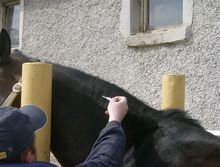For years, equine owners have been implanting microchips into horses for unique and unalterable identification. While the safety and practicality of this practice is well-established, there is little information available about trace-ability of microchips. Given the long lifespan of horses, the ability to trace microchips over many years is necessary.

Micro chipping a horse
Maintenance of data related to each horse that is micro-chipped and a structure of trace ability must be established for microchips to serve their intended identification purposes.
© 2018 by Izvora
According to Angela Pelzel-McCluskey, DVM, USDA-APHIS-Veterinary Services Fort Collins, CO, in an article in the Equine Disease Quarterly, January 2018, trace ability of horse microchips throughout the life time of a horse is very important for several reasons.
- Regulatory officials use the microchip of a horse involved in a disease investigation to trace back to additional exposed horses or premises.
- First responders to natural disasters have significant challenges in identifying ownership of displaced horses.
- Individuals searching for a lost or stolen horse have a critical reliance on trace ability of microchips.
- Equine rescue groups encounter horses that have lost their identity and endeavor to trace any permanent identification available to uncover their history.
Current methods available for tracing microchips are limited. Each trace begins with scanning a horse with a microchip-reading device and obtaining a microchip number. But what next?
If the phenotype or history of the horse presents clues to a breed or discipline group that might have the horse’s information, this is often the best place start.
If there is no obvious place to begin the inquiry, then one contacts the manufacturer of the microchip. The first three digits of the microchip number indicate the manufacturer or country code, which can be looked up online.
The manufacturer provides contact information for the distributor to which the microchip was sold. Contacting the distributor yields information for the next entity that acquired the microchip until an entity is reached that maintains data connecting the microchip to the horse. This can be a time-consuming process.
Attempts to trace microchips have highlighted some significant challenges. Multiple parties are involved in and expectedly responsible for keeping records associated with each microchip. Failure to keep or transfer records at any step in the pathway yields a permanent dead end, rendering the microchip essentially useless.
The best outcomes in tracing have been achieved when the end information is maintained by breed registries or other equine industry groups with a vested interest in connecting the horse to its unique identification.
Contact with the manufacturer has reliably been successful in obtaining the distributor information, but this approach is time consuming and not practical in urgent situations, such as a contagious disease outbreak. Since some microchip manufacturers do not require distributors to maintain records on each microchip sold, tracing through a manufacturer sometimes results in a dead-end trace.
Importance of accessible online lookup tool for equine microchips
A publicly accessible online lookup tool for equine microchips is needed to streamline the trace-back process. Such a lookup tool could provide quick identification and contact information of the main entity (breed registry, discipline group, registration system) holding information on that particular microchip number while maintaining the security and confidentiality of the data until a specific request is made for information disclosure.
Above all it must be recognized by the equine industry that simply implanting microchips in horses is not enough. There must be maintenance of data and structure of trace ability built in behind the microchips for their intended purposes to be fulfilled.
Horse owners can become part of a movement toward making sure adequate records of microchips in their horses are properly recorded by involved veterinarians and themselves in case it is needed in the future to identify and track the horse for the above reasons.
